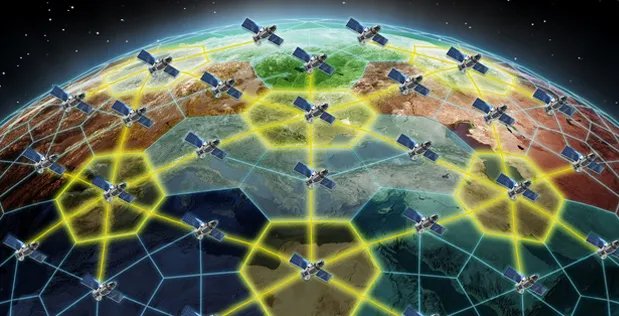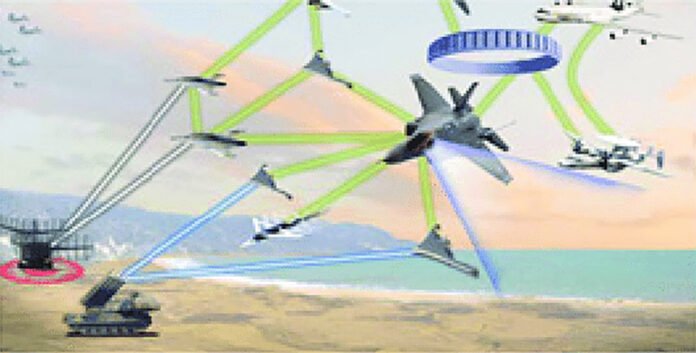The nature of warfare continues to undergo a fundamental transformation as advances in technology and dynamic security threats redefine the way in which nations plan and execute military operations. The adaptability, decentralised operational philosophy, and resilience in the face of adversarial disruptions of mosaic warfare have contributed to its significant traction among the numerous new strategic doctrines that are emerging globally. In contrast to the historical reliance on centralised, vast military platforms, this doctrine envisions militaries as networks of interoperable, modular, and flexible assets, each of which contributes as a “tile” to a dynamic operational mosaic.
Comprehending Mosaic Warfare
Mosaic warfare emphasises the displacement of traditional militaries from their monolithic and hierarchical structures. Typically, assets such as aircraft carriers, fighter jets, and tanks serve as the operational backbone. However, they are also vulnerable to targeted devastation, which could result in significant operational setbacks.
In contrast, mosaic warfare is a configuration in which operations are dispersed across a network of small, modular systems, including drones, autonomous vehicles, sensor nodes, and AI-powered platforms, each of which is capable of operating independently or in conjunction. In this distributed architecture, the operational matrix is not collapsed by individual losses; survivors adapt and persist. This improves the force’s adaptability, guarantees consistent operational momentum, and increases battlefield survivability.
Resilience, intrinsically ingrained in the mosaic doctrine, guarantees the force’s ability to function effectively in the face of casualties or disabled segments. In traditional doctrine, the loss of a large aircraft carrier results in a significant reduction in combat capability. However, under mosaic, the loss of a single drone or robotic scout does not disrupt the overall operation
The Pillars of Mosaic Warfare
Several fundamental principles distinguish mosaic warfare from legacy strategies. Modularity fundamentally characterises this method. Platforms are intended to be swiftly reconfigured to accommodate various missions, such as converting a reconnaissance drone into a strike asset or repurposing surveillance robots for combat support. This adaptability enables militaries to personalise their toolkits to suit particular tactical scenarios without necessitating bespoke assets for each function.
Decentralisation further enhances the model by relocating decision-making to the network’s edge. Mosaic warfare allows units to make autonomous decisions based on real-time data and shared objectives, rather than directing all operations through hierarchical command posts, which can become bottlenecks and singular points of failure. When the operational situation necessitates a collective response, units are able to coordinate seamlessly while still being capable of independent action.
Interoperability is essential for the establishment of a genuine operational mosaic. Advanced networking and secure, software-defined radios (SDRs) that surpass legacy communication barriers are essential for platforms to communicate seamlessly across domains—air, land, sea, and space. The integrity of command and data flows is guaranteed by secure, encrypted connections, which is particularly important in multi-domain conflict, where cyber operations are increasingly prevalent.
Resilience, intrinsically ingrained in the mosaic doctrine, guarantees the force’s ability to function effectively in the face of casualties or disabled segments. In traditional doctrine, the loss of a large aircraft carrier results in a significant reduction in combat capability. However, under mosaic, the loss of a single drone or robotic scout does not disrupt the overall operation. Modular design and intelligent control architectures facilitate the final critical component, adaptability. Units can quickly reconfigure their missions and roles in response to emerging threats, environmental shifts, or enemy tactics.
The maritime domain is also represented by autonomous underwater and surface vehicles, which support naval surveillance and anti-submarine missions in contested seas. All of these unmanned systems—airborne, terrestrial, and maritime—are designed to operate independently and synchronise with the broader military mosaic when necessary
DRDO and India’s Drive towards Mosaic Military Systems
DRDO is instrumental in the research, development, and operational experimentation that underpins India’s adaptation of mosaic warfare, which is contingent upon indigenous innovation. This initiative is illustrated by the Rustom series of Unmanned Aerial Vehicles (UAVs). These medium-altitude, long-endurance drones are intended for protracted combat strike, surveillance, and reconnaissance missions. Additionally, their modular architecture enables them to rapidly adapt to new payloads or duties, while their ability to operate autonomously for extended periods reduces the risk to human warfighters. The broader mosaic effect can be facilitated by the networking of multiple Rustom UAVs into combined missions.
DRDO’s Unmanned Ground Vehicles (UGVs) further improve ground operations by offering robotics support for direct action, logistics, and reconnaissance in hazardous environments. These ground robots are responsible for the disposal of bombs, forward reconnaissance, and resupply—essential, low-profile capabilities that enhance operational resilience. The maritime domain is also represented by autonomous underwater and surface vehicles, which support naval surveillance and anti-submarine missions in contested seas. All of these unmanned systems—airborne, terrestrial, and maritime—are designed to operate independently and synchronise with the broader military mosaic when necessary.
The redundancy and operational flexibility that mosaic warfare necessitates are both underpinned by the guarantee of uninterrupted, secure communication, which prevents adversarial disruption of command, control, or intelligence cycles
Sensor Networks and Real-Time Data Fusion
The integration of distributed sensor networks and the fusion of their data streams are critical enablers of mosaic warfare. Radar, electro-optical, infrared, acoustic, and chemical sensor platforms that are capable of environmental monitoring, target tracking, and persistent surveillance are among the innovations of DRDO. These are not independent collectors; the true power is in the seamless integration of disparate sensor signals into a single situational picture, which is facilitated by data analytics and AI algorithms.
DRDO’s AI-enhanced data fusion platforms can rapidly identify targets and threats by integrating inputs from drones, satellites, and ground sensors, resulting in the compilation of actionable intelligence. Indian commanders and algorithms are granted an operational advantage by this real-time awareness, which enables the coordination of “tiles” for maximal effect across the battlespace, thereby enabling shock-resistant patterns of action.
Interoperability, Communication, and Cyber Defence
A functioning mosaic necessitates interoperable and secure communication. In this context, DRDO’s software-defined radio initiatives facilitate wide-spectrum communications by connecting manned units, satellites, and unmanned aerial vehicles (UAVs) in a reconfigurable, agile network. Regardless of the original platform protocols, data transmission and reception foster a unified effort across various technological generations.
Cyber defence plays an equally critical role in these communication networks. DRDO has prioritised encryption, anti-jam systems, and resilient radio protocols in response to the persistent threats of digital interception and interference. The redundancy and operational flexibility that mosaic warfare necessitates are both underpinned by the guarantee of uninterrupted, secure communication, which prevents adversarial disruption of command, control, or intelligence cycles.
India’s adoption of mosaic warfare addresses several national security priorities. The doctrine provides a cost-effective approach to military modernisation, employing a multitude of affordable systems rather than a small number of expensive, vulnerable platforms
Autonomous Decision-Making and Artificial Intelligence
The decentralised, responsive character of mosaic warfare necessitates artificial intelligence at every level. DRDO has made huge investments in the development of AI for autonomous navigation, target recognition, sensor fusion, and situational response. For instance, autonomous drones can determine the optimal route through intricate environments, reroute in response to obstacles or threats, and even determine when to strike or retreat based on mission objectives and battlefield inputs.
The power of AI is derived from its ability to allow machines to process sensor data, classify targets, and coordinate multi-platform operations without the need for human instructions. This level of autonomy expedites the pace of operations, aligns with the adaptive cadence of mosaic warfare, and enables commanders to concentrate on a more comprehensive strategy, confiding in the “tiles” to execute with precision and initiative.

Strategic Implications for India
India’s adoption of mosaic warfare addresses several national security priorities. The doctrine provides a cost-effective approach to military modernisation, employing a multitude of affordable systems rather than a small number of expensive, vulnerable platforms. It is in perfect harmony with the government’s vision of technological self-reliance, as it fully leverages indigenous research and incremental innovation to decrease foreign dependencies.
Mosaic warfare provides the Indian military with the ability to transition between conventional warfare, counterinsurgency, and hybrid challenges, such as cyber and electronic warfare, on a more comprehensive strategic level. India’s defence establishment, with the assistance of DRDO, is constructing a combat force that is capable of absorbing shocks, continuing to fight, and swiftly adapting in response to the evolving security environment, as threats become more intricate and unpredictable. These attributes are indispensable for the protection of national interests in the emerging security environment.
The transition to mosaic warfare is not merely a doctrinal change; it is a transformative strategy for the organisation and outfitting of India’s armed forces in anticipation of 21st-century threats. DRDO’s dedication to modular autonomous systems, sensor integration, AI, and resilient command architectures is laying the foundation for a future-proof, battle-ready military
Toward a Future-Ready Force
The transition to mosaic warfare is not merely a doctrinal change; it is a transformative strategy for the organisation and outfitting of India’s armed forces in anticipation of 21st-century threats. DRDO’s dedication to modular autonomous systems, sensor integration, AI, and resilient command architectures is laying the foundation for a future-proof, battle-ready military. The fundamental strengths of mosaic warfare—adaptability, resilience, modularity, and autonomy—provide a robust response to contemporary conflict, guaranteeing that India’s defence apparatus remains effective regardless of the challenge. India is advancing toward a more strategic depth, operational flexibility, and self-reliance on the global stage as DRDO takes the lead.
The writer is the Publisher of Frontier India and the author of the book Foxtrot to Arihant: The Story of Indian Navy’s Submarine Arm.






